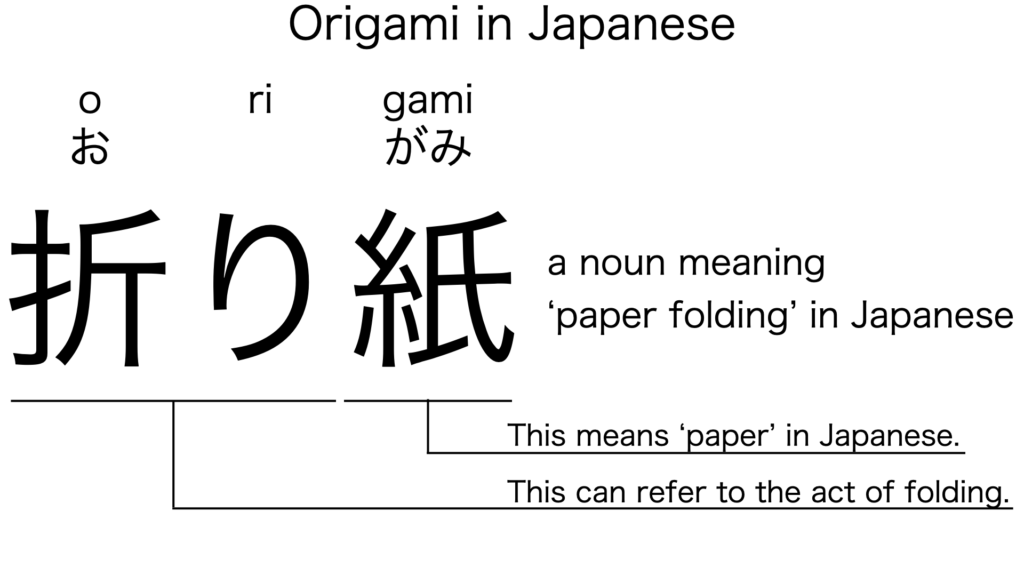What does “origami” mean in Japanese?
Native speakers use origami to mean ‘paper folding’ in Japanese. Perhaps, some Japanese learners know this word as it has already been exported to many countries as part of the Japanese culture. In this blog post, however, I’m explaining this word in detail based on its kanji mixed expression. And also, I’m explaining how to use it through example sentences. My explanations would help Japanese learners understand origami more clearly. Then, let’s get started!
Contents
The definition and meaning of “origami”
Let me start with the definition and meaning of origami.
- origami – 折り紙 (おりがみ) : a noun used to mean ‘paper folding’ in Japanese.
Japanese native speakers use this noun to refer to the art of folding paper into beautiful shapes or the process of folding.
The definition and meaning are simple and clear. To understand this noun more clearly, however, let me explain its kanji mixed expression in detail.
Origami in kanji
The kanji mixed expression of origami contains the following two kanji characters:
- 折 : a kanji character used to refer to the act of folding, bending, or breaking in Japanese.
- 紙 : a kanji character used to mean ‘paper’ in Japanese.
From these two kanji characters, we can understand that origami literally means ‘folding paper’ in Japanese. This literal interpretation is very close to the actual meaning.

When we meet new kanji expressions, we should check their kanji characters in detail to understand their meanings clearly and deeply. In many cases, kanji characters tell us a lot about the meanings of the expressions they form. Actually, here, we could get the better understanding of origami through the detailed check above.
So far, I’ve explained the definition and meaning of origami together with its kanji characters. Then, let me explain how to use it through the example sentences below.
How to say “paper folding” in Japanese
watashi tachi wa kinou origami wo narat ta – 私達は昨日折り紙を習った (わたしたちはきのうおりがみをならった)
We learned paper folding yesterday.
Below are the new words used in the example sentence.
- watashi – 私 (わたし) : a pronoun meaning ‘I’ in Japanese.
- tachi – 達 (たち) : a suffix used after a noun or pronoun to make its plural form. In the example, this is used after watashi to make its plural form, watashi tachi, which means ‘we’ in Japanese. Learn more about Japanese plural.
- wa – は : a binding particle working as a case marker or topic marker. In the example, this works after watashi tachi to make the subject in the sentence.
- kinou – 昨日 (きのう) : a noun meaning ‘yesterday’ in Japanese. This can also work as an adverb almost anywhere in a sentence. In the example, this works as an adverb in the middle of the sentence to mean ‘yesterday’ in Japanese.
- wo – を : a case particle used to make the object word in a sentence. In the example, this is used after origami to make the object in the sentence.
- narat – 習っ (ならっ) : one conjugation of the verb, narau, which means ‘to learn’ in Japanese. In the example, it has been conjugated for the better connection with its following word.
- ta – た : an auxiliary verb used after a verb, adjective, or auxiliary verb to make its past tense form. In the example, this is used after narat to make its past tense form, narat ta.
This is a typical usage of origami. In this example, it works together with the case particle, wo, to become the object in the sentence.
Another example of “origami”
kanojo wa origami ga suki desu – 彼女は折り紙が好きです (かのじょはおりがみがすきです)
She loves paper folding.
Below are the new words used in the example sentence.
- kanojo – 彼女 (かのじょ) : a pronoun meaning ‘she’ in Japanese.
- ga – が : a case particle used to make the subject word or the object word in a sentence. In the example, this is used after origami to make the object in the sentence.
- suki – 好き (すき) : the stem part of the na-adjective, sukina, which means ‘favorite’ in Japanese. Native speakers, however, often use this as an individual word to mean ‘to like’ or ‘to love’ in Japanese. In the example, this is used to mean ‘to love’ in Japanese.
- desu – です : an auxiliary verb used after a noun or adjective to make it polite. Probably, this is well known as a part of the Japanese desu form. In the example, this is used after suki to make it sound polite.
This is another example of origami. In this example, it works together with the case particle, ga, to become the object in the sentence. When we want to mean ‘paper folding’ in Japanese, anyway, origami is always the best option.
Summary
In this blog post, I’ve explained the definition and meaning of origami in detail based on its kanji mixed expression. And also, I’ve explained how to use it through the example sentences. Let me summarize them as follows.
- origami – 折り紙 (おりがみ) : a noun used to mean ‘paper folding’ in Japanese. These two kanji characters literally mean ‘folding paper’ in Japanese. This literal interpretation is very close to the actual meaning. Japanese native speakers use this noun to refer to the art of folding paper into beautiful shapes or the process of folding.
Hope my explanations are understandable and helpful for Japanese learners.
Leave a Reply